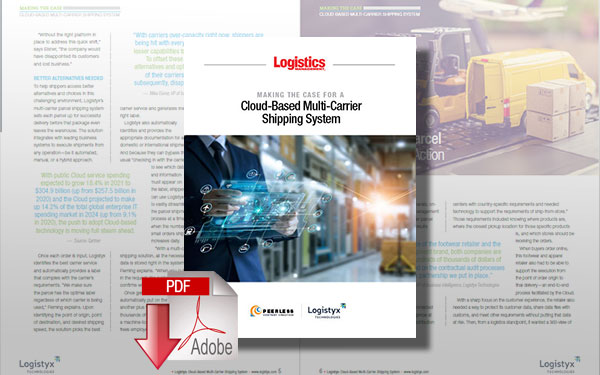Multi-Carrier Parcel Shipping Systems - Use Cases, Advantages, and Strategies

Let’s take a closer look at multi-carrier parcel shipping successful use cases to learn about some of the advantages of getting it right.
Multi-Carrier Parcel Shipping
We’re exposed to multi-carrier parcel shipping every day. From the Amazon truck in front of our house to the FedEx van next door to the UPS driver across the street, shippers are constantly moving parcels with the carriers in their transportation network.
By leveraging special carrier services, “gig economy” carriers, and ship-from-store, companies like Pfizer, Walgreens, and Belk are setting the stage for the next generation of omnichannel distribution.
When you hone and optimize your parcel shipping strategy across multiple carriers, you get some serious advantages. A couple of them are lowering overall transportation costs and offering customers a broader choice of shipping options.
Let’s take a closer look at multi-carrier parcel shipping and some of the most successful examples to learn about some of the advantages of getting it right.
Multi-Carrier Parcel Shipping Systems: An Overview
As e-commerce keeps growing, carrier demand has surged, while resources and capacity dwindle. Carriers’ responses to this intensifying demand and industry volatility have been two-fold. First, many carriers have alerted enterprise shippers in recent months they would not be able to take their packages. Second, several carriers announced surcharges. Globally, carriers in all hemispheres are taking similar steps to offset costs.
A multi-carrier parcel shipping system makes it easy to increase agility during a supply chain disruption by providing shippers with the ability to quickly onboard, leverage, and optimize multiple carrier services, including regional and last-mile providers, while also producing the data and analytics necessary to uncover opportunities to increase savings and on-time delivery performance.
It’s a lifeline to logistics professionals seeking to rapidly increase their available shipping options to manage any issues that arise and deliver products to customers on time, and it serves as a reliable method to reduce transportation and fulfillment costs. Typical quantitative ROI calculations show the investment payback well within 12 months of implementation.
Advantages of a Multi-Carrier Parcel Shipping System
Modern multi-carrier parcel shipping software, even at a basic level and price point, provides several prime advantages when it comes to a carrier services network, parcel delivery event tracking, and business system integration.
It can catapult order fulfillment workflows into the future by unlocking a host of cross-border, omnichannel distribution capabilities. Here are some of the biggest advantages to getting your multi-carrier parcel shipping software solution decision right.
Ensure carrier capacity and flexibility in every shipping scenario
Even in the face of a crisis, it’s possible to successfully navigate carrier capacity limitations and minimize the impact of surcharges by leaning on a wide network of carriers. A large carrier network allows you to:
- Distribute parcel volumes across various providers
- Shop carrier rates and reduce the impact of surcharges
- Automatically determine the ideal service or combination of carriers for each shipment in real time
The right multi-carrier parcel shipping solution will be built on cloud architecture, so that carriers on-boarded once are available for all customers, allowing for faster implementations and common interfaces. It will also have an extensive number of national, regional, and local carrier services in its carrier library, empowering you to land an integrated transportation strategy worldwide.
Guarantee the best customer experience
To achieve on-time delivery in full and guarantee the best customer experience, you have to have your eye on all shipments at all times. Seems impossible? With the ad hoc and real-time reporting tools in a multi-carrier parcel shipping system, that’s precisely the level of visibility you gain.
The right solution will have a Control Tower, so as your parcel shipments move through your carriers’ global supply chains, you’ll receive instant warning alerts if a parcel is off-track or behind schedule.
These alerts will enable you to proactively address delivery events such as late or damaged shipments to meet your customers’ expectations and maintain your delivery KPIs.
Even better: sophisticated solutions will collect and analyze data and generate reports across all shipment attributes including spend, geography, carriers, and even SKUs – empowering you to continuously streamline your transportation activity, increase efficiency, improve delivery performance, and save money.
Plan transportation strategies with better data and integrations
In omnichannel distribution in particular, many facilities are required to perform multiple types of fulfillment within the same four walls. And while most operations already fulfill e-commerce orders through a mix of in-store and direct-to-consumer fulfillment, an omnichannel strategy complicates matters by introducing alternate order fulfillment methods such as:
- Buy Online, Pick-up in Store (BOPIS)
- Ship-from-store these new channels can introduce “noise” and complicate a shipper’s operations. The right solution will integrate with supply chain technology such as WMS, OMS, and e-commerce systems in the cloud, eliminating this “noise” and enabling key stakeholders in your organization to:
- Run rate simulations and compare “what if” to current transportation strategies
- Set and measure parcel shipping KPIs
- Identify carrier delivery performance issues
- Prepare for carrier negotiations
Specific Multi-Carrier Shipping Solution Use Cases
Download: Cloud-Based Multi-Carrier Shipping System
Rising transportation costs, a truck driver shortage, and carrier capacity crunches are all creating new complexities for shippers in the current operating environment.
Add a persistent labor shortage, the e-commerce boom, and the need for robust consumer data protections to the equation, and the situation becomes even more difficult for the typical company to navigate.

No two companies approach parcel shipping the exact same way, but there are similarities to notice across successful companies. Seamless systems integrations, reliance on Business Intelligence, and a consistent customer experience are all themes that show up again and again. Here are specific examples of how Pfizer, Walgreens, and Foot Locker each focus on multi-carrier parcel shipping.
Pfizer
To meet the complex shipping requirements of its life-saving vaccine shipments, Pfizer turned to Logistyx’s multi-carrier parcel shipping system to incorporate shipping directly from manufacturing locations in Kalamazoo, Mich.; Purrs, Belgium; and Karlsruhe, Germany as well as other facilities in Pleasant Prairie, Wisc. and Memphis, Tenn. Data produced by Logistyx is automatically fed to contracted carriers to aid in carrier-provided customs clearance and accelerate the international shipping process.
Logistyx also onboarded DHL and UPS Air Freight as new carriers capable of meeting the vaccine’s cold chain requirements and expanded its use of UPS internationally to facilitate rapid global vaccine distribution.
Most COVID-19 vaccine shipments are now fulfilled via small parcel utilizing UPS, FedEx, or DHL. Each parcel is highly sensitive, contains several kilograms of dry ice and a GPS tracking device, and receives special handling by the carriers while being shipped via the fastest methods available. Logistyx creates the required labels for every parcel sent to ensure compliance with each carrier’s unique requirements.
Walgreens
Walgreens leveraged Logistyx’s multi-carrier parcel shipping system to expand its e-commerce offering by introducing Same Day Delivery in under two hours for more than 24,000 retail products. The new service allows customers across the nation to conveniently shop online or use the Walgreens app to buy retail items with no minimum order value.
When checking out, customers can select Same Day Delivery and receive items at their doors in under two hours through third-party delivery partners like Postmates, DoorDash, and Instacart. Walgreens’ Same Day Delivery service builds on its pickup options implemented in November 2020, which allow customers to place orders for in-store, curbside, or drive-thru pickup in as little as 30 minutes.
The pharmacy chain has also partnered with FedEx over the last few years to provide prescription delivery services for greater ease and accessibility.
Before and since the pandemic began, Walgreens has modified its omnichannel fulfillment offerings and successfully adapted and reorganized to evolve along with the marketplace and help meet customers’ growing demands for convenience and safety.
Adopting an agile approach to shipping and fulfillment to create a flexible supply chain helps Walgreens work more effectively to increase responsiveness and improve customer experiences.
Belk
Logistyx’s multi-carrier parcel shipping system provides Belk’s stores with instant access to carriers and services offering the best rates for each particular location. Seamlessly integrated with Belk’s order management software, the solution supports multi-carrier rate shopping, shipment execution and label generation, real-time shipment tracking, and delivery transparency.
Leveraging Logistyx, Belk utilizes its stores as mini distribution centers without having to employ major process changes to get shipments to customers’ homes, a key advantage when parcel count increased considerably due to the COVID-19 pandemic. And when faced with carrier capacity limits, Logistyx helped Belk grow its carrier network by tapping into its library of more than 550 carrier integrations.
This added greater capacity into Belk’s parcel delivery mix by introducing more options through using regional and specialty last-mile carriers, while also reducing transportation costs to provide a consistent level of service to customers.
Optimize your parcel shipping strategy today
Now that you know the advantages you can get from doing multi-carrier parcel shipping right and have some examples from some of the world’s leading companies, you can start to create your own strategy. But in order to put your multi-carrier parcel shipping strategy into action, you’ll need a powerful tool.
A cloud multi-carrier shipping system can support and scale your shipping operations. Watch our webinar, How to Drive your Carrier Network to Success, to learn more.
Related White Paper
Cloud-Based Multi-Carrier Shipping System
Shippers that look at cloud-based systems will be well-positioned to take on higher-order volumes, improve customer satisfaction, and grow their bottom lines.
Article Topics
Logistyx Technologies News & Resources
Prologis and Home Depot leadership address the capabilities of AI for logistics Maersk addresses flexibility and variability with innovation Embracing the Cross-Border E-Commerce Opportunity Optimize Your Parcel Shipping Strategy Why Peak Season Planning Needs to be a Year-Round Endeavor 7 Logistics Trends that will Radically Change the Shipping Landscape in 2022 E2open makes second acquisition in less than a year, bringing Logistyx Technologies into the fold More Logistyx TechnologiesLatest in Supply Chain
Ranking the Top 20 Women in Supply Chain TIm Cook Says Apple Plans to Increase Investments in Vietnam Talking Supply Chain: Doomsday never arrives for Baltimore bridge collapse impacts Amazon Logistics’ Growth Shakes Up Shipping Industry in 2023 Spotlight Startup: Cart.com is Reimagining Logistics Walmart and Swisslog Expand Partnership with New Texas Facility Nissan Channels Tesla With Its Latest Manufacturing Process More Supply Chain













